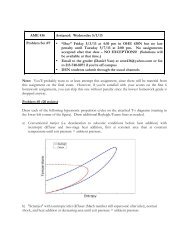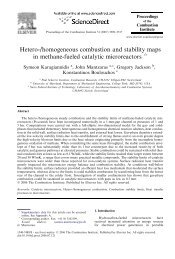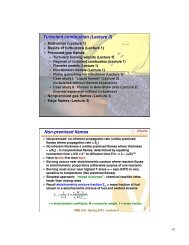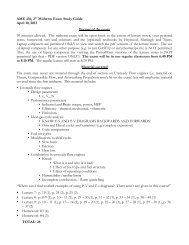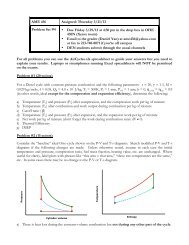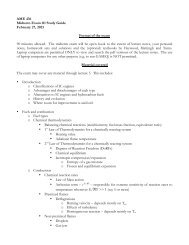AME 436
AME 436
AME 436
You also want an ePaper? Increase the reach of your titles
YUMPU automatically turns print PDFs into web optimized ePapers that Google loves.
Otto vs. Diesel cycle comparison"<br />
Pressure (atm)<br />
12.0<br />
10.0<br />
8.0<br />
6.0<br />
4.0<br />
2.0<br />
Compression Combustion Expansion<br />
Blowdown Intake Exhaust<br />
Intake start 1 2<br />
3 4 5<br />
6 7<br />
Otto<br />
Diesel<br />
P-V diagram<br />
0.0<br />
0.E+00 1.E-04 2.E-04 3.E-04 4.E-04 5.E-04 6.E-04<br />
Cylinder volume (m^3)<br />
Unthrottled Otto & Diesel with same compression ratio & heat<br />
input: Otto has higher peak P & T, more work output<br />
<strong>AME</strong> <strong>436</strong> - Lecture 8 - Spring 2013 - Ideal cycle analysis<br />
29<br />
Temperature (K)<br />
1200<br />
1000<br />
800<br />
600<br />
400<br />
200<br />
Compression Combustion Expansion<br />
Blowdown Intake Exhaust<br />
Close T-s cycle 1 2<br />
3 4 5<br />
6 7<br />
Otto vs. Diesel cycle (animation)"<br />
T-s diagram<br />
Equal areas<br />
Diesel<br />
Otto<br />
Otto work<br />
Diesel work<br />
Otto heat input<br />
Diesel heat input<br />
0<br />
-200 0 200 400 600 800<br />
Entropy (J/kg-K)<br />
Otto clearly has higher η th - every Carnot strip has same T L for both<br />
cycles, but every Otto strip has higher T H<br />
Unlike Otto cycle, η th for Diesel cannot be determined by inspection of the<br />
T - s diagram since each Carnot cycle strip has a different 1 - T L /T H<br />
<strong>AME</strong> <strong>436</strong> - Lecture 8 - Spring 2013 - Ideal cycle analysis<br />
30<br />
• 15





